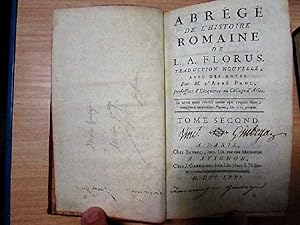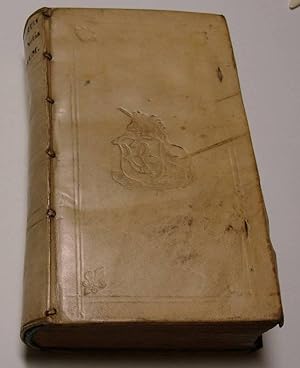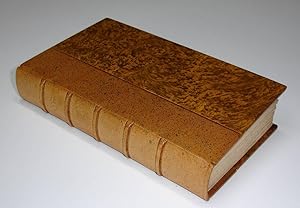L.A. Florus (4 Ergebnisse)
Produktart
- Alle Produktarten
- Bücher (4)
- Magazine & Zeitschriften
- Comics
- Noten
- Kunst, Grafik & Poster
- Fotografien
- Karten
-
Manuskripte &
Papierantiquitäten
Zustand
- Alle
- Neu
- Antiquarisch/Gebraucht
Einband
- alle Einbände
- Hardcover (1)
- Softcover
Weitere Eigenschaften
- Erstausgabe
- Signiert
- Schutzumschlag
- Angebotsfoto (3)
Land des Verkäufers
Verkäuferbewertung
-
Abrege de l Histoire Romaine de L.A. Florus
Verlag: Paris, 1771
Anbieter: Bookstore-Online, Mattsies, Deutschland
Buch
Hardcover/Pappeinband. Zustand: Gut. Aus dem Buch nicht ersichtlich. 301 Seiten Das Buch befindet sich in einem gebrauchten, noch guten Zustand. Es ist gebraucht und hat nur geringe Gebrauchsspuren, wie Verfärbung der Schnittkanten, Abrieb an den Kanten vom Einband. das Buch trägt auf der ersten Seite einen nicht näher lesbaren Namenseintrag. Das Buch ist antiquarisch und wir können keine Garantie auf Vollzähligkeit machen. Es scheint offenbar nichts zu fehlen, aber aus Unkenntnis der Zusammensetzung des Buches können wir keine Vollzähligkeit garantieren. Bitte fragen sie vor Bestellung an, falls sie den genauen Inhalt kennen.Nichtraucherbuch. Rik153275SK Sprache: Französisch Gewicht in Gramm: 230.
-
L.A. Florus cum notis Cl. Salmasii et selectissimis Variarum accurante S.M.D.C. additus etiam L. Ampelius ex Bibliotheca Cl. Salmasii.
Verlag: ex Officina Elzeviriana,, Amstelodami,, 1660
Anbieter: Studio Bibliografico Benacense, Riva del garda, Italien
Cm. 18, pp. (16) 588 (106) 46 + 1 cb. Bel frontespizio inciso in rame. Leg. coeva in piena pelle, dorso a nervi con titoli e fregi in oro. Ottima conservazione. Bella e nitida edizione elzeviriana contenente i 4 libri delle "Epitome rerum romanarum" le "Epitome altera Historiae Romanae". Cfr. Graesse II, 605.
-
L.A. Florus cum notis integris Cl. Salmasii et selectissimis Variorum, accurante S.M.D.C. Additus etiam L. Ampelius ex Bibliotheca Cl. Salmasii.
Verlag: Amsterdam (Amstelodami), Ex officina Elzeviriana, 1674., 1674
Anbieter: Antiquariaat Fragmenta Selecta, AMSTERDAM, Niederlande
8vo. (XVI),588,(108 index),46,(2 blank) p. Overlapping vellum 20.5 cm (Ref: STCN ppn 842457577; Willems 1490; Berghman 2064; Rahir 1598; Schweiger 2,361; Ebert 7683. Spoelder p. 613, Hoorn 2) (Details: Prize copy, without the prize. 6 thongs laced through both joints. Blind stamped fleurs de lis on the back. Boards with blind double fillet borders, in the center of them the coat of arms of the city of Hoorn. Engraved title, depicting a throned goddess Roma on a pedestal, allegorical figures, representing Europe, Asia and Africa offer her their treasures; in the foreground Tibur, and little Romulus and Remus and their shewolf) (Condition: Prize gone. vellum age-toned, slightly soiled and scratched. All 4 textile fastening ties gone. Front flyleaf gone. Title slightly worn. Name on the front pastedown) (Note: 'Favourite school-book in the 17th century'. This is the chief work of the Roman historian Lucius Annaeus Florus, who lived at the beginning 2nd century AD. It is an abridgement of Roman history with special reference to the wars waged up to the age of Augustus. Florus 'shows a certain literary gift, marred, however, by a strong tendency to rhetoric. His brevity often entails obscurity, though he sometimes produces a felicitous epigram. (.) As an historian he is often inaccurate in both chronology and geography, but the work as a whole achieves a limited success as a rapid sketch of Roman military history. It was a favourite school-book in the 17th century'. (OCD, 2nd ed. p. 442) § This edition is a socalled 'Variorum edition'. It offers a 'textus receptus' which is widely accepted, accompanied with the commentary and the annotations of various specialists, taken or excerpted from earlier useful, normative or renewing editions. Editions like these, 'cum notis Variorum', were useful, but never broke new ground. The production of these sometimes overloaded editions was the specialty of Dutch scholars of the 17th and 18th century. The compilers seldom were great scholars, but often hard working schoolmasters. Their involvement in publishing a new edition was limited to the necessary, but ungrateful task of the beast of burden. § This Variorum edition was produced by, so the title says, S.M.D.C, that is by Cornelis Schrevelius, who took his doctoral degree in Paris as a Doctor of Medicine in 1627. Hence S.M.D.C., that is Schrevelius Medicus Doctor Cornelis. He taught classics at the Schola Latina at Leiden, where he had been raised himself. In 1642 he succeeded his father, Theodorus Schrevelius, as the rector (Moderator) of the school. He died in 1664, a few days after having completed an edition of Claudian. He raised at least 11 kids, and fell victim to the plague. (A.M. Coebergh van den Braak, Meer dan zes eeuwen Leids Gymnasium, Leiden, 1988, p. 47/55) § This edition of 1674 is a reissue of the Elzevier edition of 1660. The commentary of the French scholar Claude Saumaise, latinized as Claudius Salmasius, 1588-1653, was adopted from the Elzevier edition of 1638, which edition included also the 'editio princeps' of the 'Liber Memorialis' of Lucius Ampelius. Salmamius was since 1631 professor at the University of Leiden) (Provenance: On the front pastedown in ballpoint: 'Lennart Hakanson', 1939-1987, professor of Latin at the university of Uppsala) (Collation: *8, AQ-2Z8, 3A4 (leaf 3A4 blank)) (Photographs on request) 700 gr.
-
Abrégé de l'Histoire Romaine de L.A. Florus. Traduction nouvelle avec des notes par M. l'Abbé Paul, professeur d'éloquence au Collége d'Arles.
Verlag: Paris, Chez les Frères Barbou, 1794 - 1795 (L'An III de la République Française), 1794
Anbieter: Antiquariaat Fragmenta Selecta, AMSTERDAM, Niederlande
12mo. (IV),384 p. Modern half calf. 18.5 cm (Ref: This edition not in Schweiger and Brunet; however cf Schweiger 2,366; cf Brunet 2/2,1312; cf Ebert 7698) (Details: Latin text with facing French translation. Back with five raised bands; marbled boards, marbled endpapers. Only the upper margin has been cut) (Condition: Small bookplate on the front pastedown. Small waterstain in the right lower corner and the left inner corner of the first 30 p. Paper yellowing) (Note: This is the chief work of the Roman historian Lucius Annaeus Florus, who lived at the beginning 2nd century AD. It is an abridgement (epitome) of Roman history with special reference to the wars waged up to the age of Augustus. Florus 'shows a certain literary gift, marred, however, by a strong tendency to rhetoric. His brevity often entails obscurity, though he sometimes produces a felicitous epigram. (.) As an historian he is often inaccurate in both chronology and geography, but the work as a whole achieves a limited success as a rapid sketch of Roman military history. It was a favourite school-book in the 17th century'. (OCD, 2nd ed. p. 442) The Abbé Armand-Laurent Paul, 1740-1809, was a French jesuit and grammarian. He wrote a number of scholarly works; the first Barbou edition of his Florus, together with his notes and translation, dates from 1774 (Brunet 2,2 p. 1312). The edition of 1774 is common, the edition of 1794 is rather rare. The translations by Paul are said to be trustworthy, but dry) (Provenance: Bookplate of the Belgian ancient historian and archaeologist Marie Therèse Charlier on the front pastedown) (Collation: pi2, A-Q12) (Photographs on request) 400 gr.





